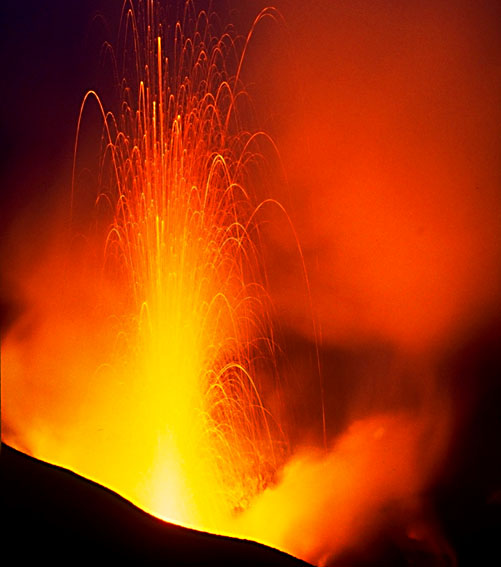September-October 2000In late September and early October 2000 the weather was rather dynamic on Stromboli. Calm days as in the first picture below were rare. As a result during the few days with sunshine and little wind hundreds of tourists rushed to the summit, making it a crowded place to stay. On other days, when a powerful Scirocco blowing, only intrepid Stromboli fanatics made the ascent but were rewarded with excellent visibility of the craters and their eruptions.
To give a sense of the perspective, camera lens focal lengths are given (i.e. f=14mm). As usual the pictures on this page link to larger photos (about 30 to 80 KB). All except one are copyright by Jürg Alean. |
 12.10.2000, f=14mm. Stromboli as seen from Strombolicchio. The plume rises nearly vertically indicating calm conditions around the summit. |  13.10.2000, f=14mm. Sciara del Fuoco from the end of the paved path (270 m.a.s.l.). Note how the Scirocco wind forces the steam down the Sciara del Fuoco, right to the surface of the sea. |  13.10.2000, f=14mm. Craters seen from Pizzo. The steam on the right is not rising. What you see is the steam trail drifting across the surface of the sea, away from Stromboli. |  13.10.2000, f=14mm. Crater terrace (centre) and Pizzo (right) as seen from the Vancori ridge. The steam trail drifting over the sea surface is now on the left. |
 13.10.2000, f=35mm. Craters seen from Pizzo. Note that because of the steam, the effect is somewhat hard to see, but the craters really are in 3D! |  10.10.2000, f=50mm. SW Crater (left) from Pizzo. Unlike most of the other pictures on this page, this was taken on 10. October when SW Crater produced massive ash clouds which obscured most of the lava. However, during this long exposure only the lava, but no trace of the ash cloud can be seen. |  10.10.2000, f=50mm. NE Crater (center and right) from Pizzo. NE Crater consisted of two adjacent depressions. Both were glowing at variable intensity, with the back one being brighter than the front one. Only about one eruption per hour took place at NEC on 10.10.2000 whereas SWC produced roughly 6/h. |  An earlier view of SWC and its eruption taken by Marco Fulle on 28. September 2000, f=50mm, from the Pizzo just before dawn. |
 13.10.2000, f=50mm. SW Crater during evening twilight. Since the 10. October SWC has totally changed its eruptive style: Eruptions occurred at a rate of about 10 per hour, producing no trace of ash and lasting much longer, occasionally more than half a minute. Nevertheless bombs hardly rose more than 50m above the crater. |  13.10.2000, f=50mm. NE Crater during evening twilight. Since the 10. October NEC had become more active, producing at least a few eruptions per hour. Their strength varied a lot: see image on the far right. All pictures in this row were taken from the ridge south of Pizzo. |  13.10.2000, f=50mm. Strong glow at NE Crater. The ambient illumination is now by the full moon. The vertical bright veil which seems to rise from the left of the crater is in fact the steam trail down on the sea, drifting away towards the Northwest (compare the pictures in the top row). |  13.10.2000, f=50mm. Eruption at NE Crater. Just before Pam, Jürg and Cristina (Jürg's goddaughter) were about to leave Pizzo, SWC delivered the Gran Finale. The subsequent descent via Rina Grande was the nicest of all we can remember. Never have we seen a moon so bright on Stromboli. It was a dream. |